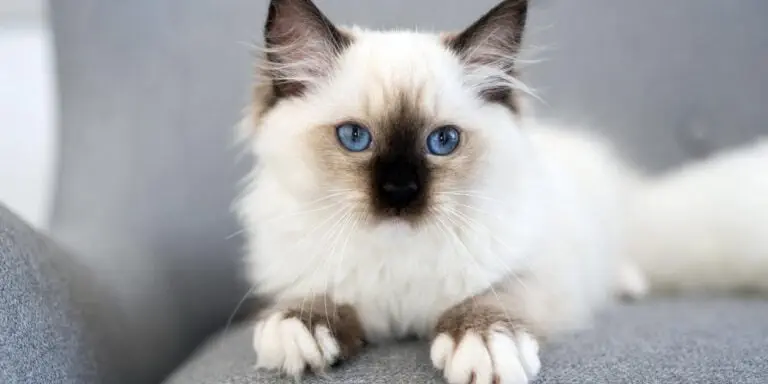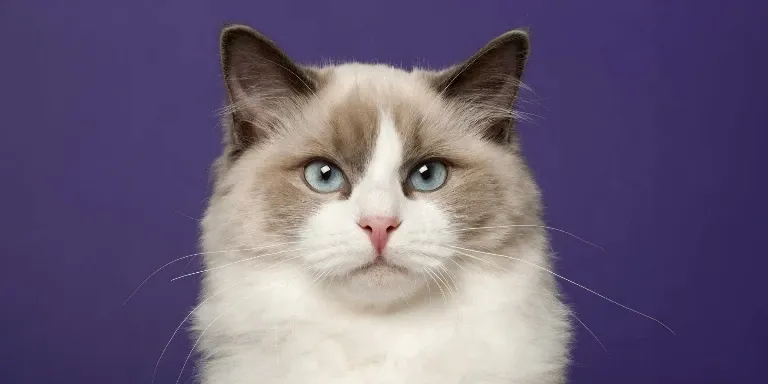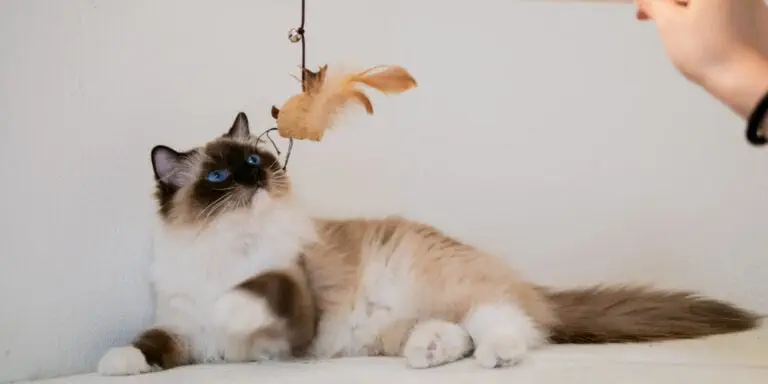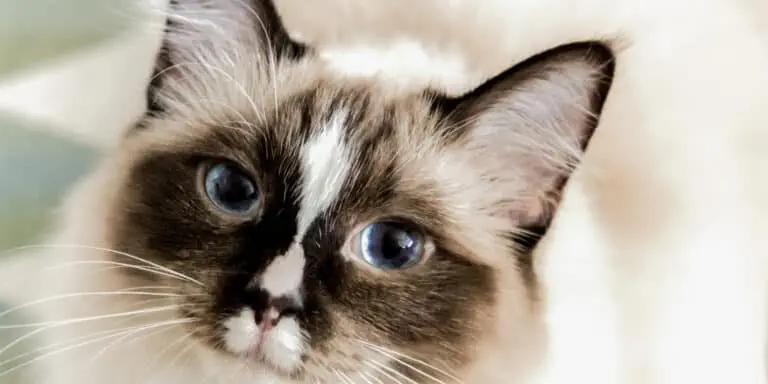The Best Fluffy Pancakes recipe you will fall in love with. Full of tips and tricks to help you make the best pancakes.
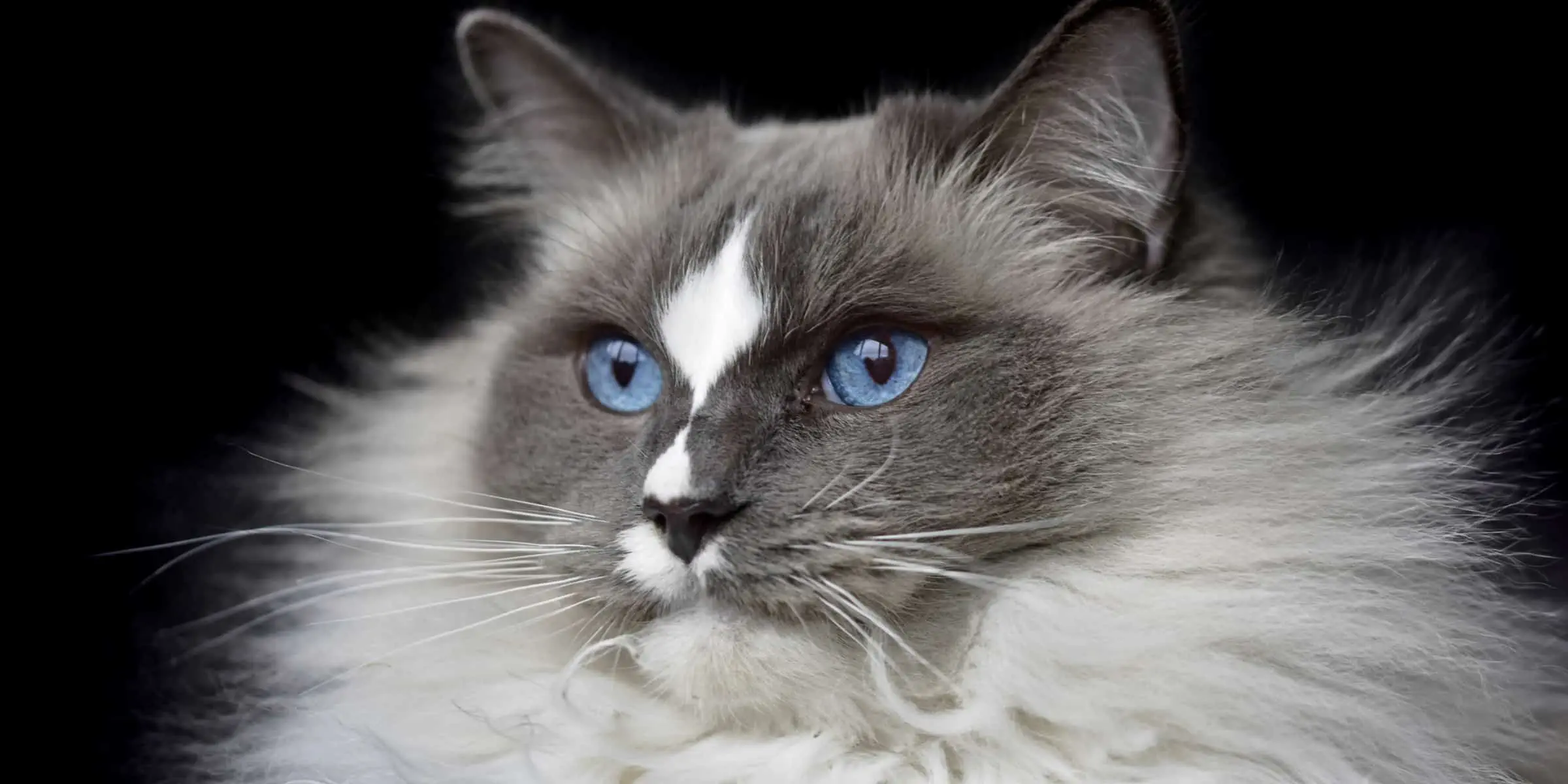
If you are considering getting a Ragdoll cat, it is important to understand both the pros and cons of owning this lovely breed. While Ragdolls are known for their affectionate and gentle nature, there are some downsides to consider before bringing one into your home.
Some cons of Ragdoll cats include their tendency to shed a lot, their need for frequent grooming to prevent matting of their fur, and their potential for health issues such as hypertrophic cardiomyopathy (HCM) and bladder stones. They also tend to be more docile and less active than other cat breeds, which may not be suitable for some owners.
Let’s take a closer look at some of these issues.
Shedding
Although ragdoll cats are generally low-maintenance, their shedding can be a bit of a challenge, especially during shedding season. If you don’t want your entire house covered in fur, shedding management is key.
Regular grooming is essential to manage shedding. Brushing your cat’s hair on a daily basis can help remove loose hair and prevent matting. Aside from brushing, other grooming techniques can also help manage shedding.
Regular baths can help remove excess hair and prevent dander buildup. However, be sure to use a cat-friendly shampoo and rinse thoroughly to avoid skin irritation. Trimming your cat’s hair can also help reduce shedding, but it’s best to consult with a professional groomer or veterinarian to avoid any accidents.
Overall, shedding can be a bit of a downside when it comes to owning a ragdoll cat. However, with proper shedding management and grooming techniques, you can keep shedding under control. Just be prepared to put in some extra effort during shedding season to keep your home tidy and your cat healthy.
Health Issues
You might want to consider the health risks of owning a ragdoll, as they can be as delicate as a flower petal. Although they’re generally healthy, there are some common health issues that you should be aware of.
For instance, they’re prone to heart diseases like hypertrophic cardiomyopathy, which is a condition that causes the heart muscle to thicken, leading to heart failure.
Another health issue that you should watch out for is urinary tract infections. Ragdoll cats are more susceptible to this because of their long hair, which can easily trap bacteria. To prevent this, make sure to regularly groom and trim their fur, and provide them with plenty of clean water to drink.
Preventative measures are essential to keeping your ragdoll healthy. Regular visits to the vet can help detect and treat health issues early on, before they worsen. Feeding them a healthy diet and keeping them active can also help maintain their overall health.
With proper care, your ragdoll can live a long, healthy life.
High Maintenance
If you’re considering getting a ragdoll cat, it’s important to know that they’re high maintenance pets. Regular brushing and grooming are necessary to maintain their beautiful silky coat and prevent matting.
Additionally, ragdolls require interactive playtime to keep them mentally stimulated and prevent boredom.
Regular Brushing and Grooming
Regular brushing and grooming is essential for maintaining the beautiful coat of a ragdoll cat. These cats have long, silky fur that can easily become matted and tangled if not properly cared for. Here are some things to keep in mind when grooming your ragdoll:
- Proper equipment: Make sure you have the appropriate tools for brushing your cat’s fur, such as a slicker brush and a metal comb. Using the wrong tools can cause discomfort or even harm to your cat.
- Groomer selection: If you’re not comfortable grooming your cat yourself, it may be worth finding a professional groomer who has experience with ragdoll cats. They can provide a thorough grooming and give you tips on how to maintain your cat’s coat.
- Benefits of regular grooming: In addition to keeping your cat’s fur looking beautiful, regular grooming can also help with shedding, reduce hairballs, and prevent skin irritation and infections.
- Frequency: It’s recommended to brush your ragdoll cat at least once a week to prevent matting and tangles. However, if your cat spends a lot of time outdoors or has a particularly thick coat, you may need to groom them more frequently.
By taking the time to regularly brush and groom your ragdoll cat, you can help keep them healthy and happy. Not only will they look their best, but they’ll also feel better without matted fur and skin irritation.
Need for Interactive Playtime
When playing with your furry ragdoll cat, it’s crucial to understand the importance of interactive playtime. Ragdoll cats are known to be friendly and affectionate, but they also need to stay active and mentally stimulated. Engaging in playtime activities with your cat can help prevent boredom, reduce stress, and keep them healthy both physically and mentally.
To ensure your ragdoll cat’s well-being, make sure to engage in interactive playtime with them every day. There are various ways to play with your cat, from using interactive toys to playing hide-and-seek games. You can also try teaching your cat new tricks or simply spending some quality time together.
The key is to find engaging activities that your cat enjoys and that can keep them mentally and physically active. By doing so, you’ll be providing your furry companion with the necessary stimulation and attention they need to thrive.
Size
Despite their adorable appearance, Ragdoll cats can grow to be quite large and may require more space than smaller cat breeds. These cats were originally bred to be larger than average, with males weighing between 15-20 pounds and females weighing between 10-15 pounds.
This size difference may not seem significant, but it can make a big difference in the amount of space a Ragdoll cat needs to feel comfortable. In addition to their size, Ragdoll cats have some physical characteristics that can make them more challenging to care for.
For example, their long fur requires regular grooming to prevent matting and tangling. This grooming process can be time-consuming and may require more effort than caring for a cat with shorter fur. Additionally, Ragdoll cats can be prone to health problems such as urinary tract issues, which can require more frequent vet visits and special dietary needs.
Despite these challenges, Ragdoll cats can make wonderful companions for the right owner. They are known for their affectionate and docile personalities, and many people enjoy their large size and fluffy appearance.
If you’re considering adopting a Ragdoll cat, be sure to do your research and prepare your home accordingly to ensure that your cat has plenty of space and receives the care and attention they need.
Clinginess
One thing to love about Ragdoll cats is how they love to be close to their humans, often following them around the house and wanting to be held and cuddled. However, this clinginess can sometimes be a downside for some owners, especially if they have a busy lifestyle.
Ragdolls can suffer from separation anxiety and may become destructive or vocal when left alone for too long. It’s important to consider this before getting a Ragdoll and to make sure you can provide enough attention and affection to keep them happy.
If you do have a Ragdoll and are struggling with their clinginess and separation anxiety, there are training techniques that can help. One method is to gradually increase the amount of time you spend away from them, starting with just a few minutes and slowly building up to longer periods.
Another technique is to provide them with plenty of toys and activities to keep them occupied while you’re away. You can also try leaving a piece of clothing with your scent on it to comfort them while you’re gone.
It’s important to remember that every cat is different and some Ragdolls may not struggle with separation anxiety at all. However, it’s always better to be prepared and know what to expect before bringing a new pet into your home. By understanding the potential downsides of Ragdoll clinginess and having some training techniques in your toolbox, you can provide your furry friend with the love and care they need to thrive.
Sensitivity
As a ragdoll cat owner, you should be aware of their sensitivity to changes in routine. These felines thrive on stability and consistency, so any disruptions to their daily schedule can cause them stress and anxiety.
Additionally, stressful environments can also have a significant impact on their well-being. It’s important to keep in mind these factors when caring for your ragdoll cat to ensure they remain healthy and happy.
Sensitive to Changes in Routine
If you’re considering a ragdoll cat, keep in mind that they can become easily stressed by changes in their routine. This breed is known for being sensitive to their environment and can take longer to adjust to new situations compared to other cats. This means that if you plan on traveling frequently or have a busy schedule that changes often, a ragdoll cat may not be the best fit for you.
Here are four things to keep in mind if you do decide to bring a ragdoll cat into your home:
- Be patient during the adjustment period – it may take your cat several weeks to get comfortable in their new environment.
- Use positive reinforcement training techniques to help them feel secure and confident.
- Stick to a consistent routine as much as possible to reduce stress.
- Consider providing a safe space for your cat, such as a designated room or cat tree, where they can retreat to if they feel overwhelmed.
May Be Affected by Stressful Environments
Living in a hectic environment can take a toll on these gentle felines, causing them to become anxious and overwhelmed. Ragdoll cats are sensitive creatures that thrive in a calm and peaceful environment. If you live in a crowded and noisy area, your furry friend may experience stress and anxiety.
Stress management is crucial for ragdoll cats, and it starts with identifying environmental factors that may trigger their anxiety. Loud noises, unfamiliar people, and sudden changes in routine can all contribute to their stress levels.
As a responsible owner, it’s important to create a safe and secure space for your furry friend to retreat to when they feel overwhelmed. This can include a cozy bed, a quiet room, and plenty of toys to keep them entertained. By understanding and managing their stress levels, you can help your ragdoll cat live a happy and healthy life.
Litter Box Issues
One downside of owning a ragdoll cat is that they may struggle with using the litter box consistently. While this issue may be frustrating, it’s important to remember that it’s not uncommon for cats to have litter box issues, and there are ways to address it.
Here are some reasons why your ragdoll cat may be struggling with using the litter box and what you can do to help:
- Medical issues: Your cat may have a medical condition that is causing them to avoid the litter box. If your cat is experiencing pain or discomfort while using the litter box, they may associate the litter box with negative feelings and avoid it altogether. If you suspect your cat has a medical issue, it’s important to take them to the vet for a check-up.
- Behavioral issues: Your cat may be avoiding the litter box due to behavioral issues. This could be due to stress, anxiety, or a lack of training. To help your cat feel more comfortable using the litter box, try providing a quiet and private location for the litter box, using a different type of litter, or using positive reinforcement techniques to encourage your cat to use the litter box.
By understanding the reasons behind your ragdoll cat’s litter box issues, you can take steps to help them overcome this problem. With patience and persistence, you can help your cat feel more comfortable using the litter box and enjoy a happier, healthier life together.
Remember to always approach the situation with kindness and understanding, and don’t hesitate to seek advice from a veterinarian or animal behaviorist if needed.
Potential for Allergies
If you’re considering getting a Ragdoll cat, it’s important to keep in mind that they have the potential to trigger allergies in some owners.
Before making a decision, it’s essential to consider whether you or anyone in your household has allergies to cats.
While Ragdolls are known for their friendly personalities and affectionate nature, it’s crucial to make an informed decision that takes into account the potential for allergies.
May Trigger Allergies in Some Owners
You may want to reconsider getting a ragdoll cat if you’re prone to allergies because their fluffy coats can feel like swimming in a pool of pollen and pet dander. Ragdoll cats are notorious for shedding a lot, which can be a nightmare for people with allergies.
Here are some ways that owning a ragdoll cat may trigger allergies:
- Sneezing: Ragdoll cats shed a lot, and their hair and dander can irritate your nose, making you sneeze frequently. This can be especially problematic if you have a sensitive nose or suffer from allergies.
- Itchy eyes: Ragdoll cats have a lot of hair, and this can cause your eyes to become itchy and watery. This can be uncomfortable and make it difficult to focus on tasks that require visual concentration.
- Breathing difficulties: For some people, being around ragdoll cats can trigger asthma attacks or make it difficult to breathe. This can be especially problematic if you have pre-existing respiratory issues.
While there are some allergy management techniques that can help reduce the impact of owning a ragdoll cat, such as regular grooming, using air purifiers, and keeping your home clean, these may not be enough for some people. If you’re set on owning a cat, you may want to consider alternative breeds that shed less and are less likely to trigger allergies.
Consider Allergies Before Choosing a Ragdoll Cat
Before adopting a cuddly feline friend, it’s important to take into account any potential allergies that may arise with certain breeds. While Ragdoll cats are known for their loving personalities and fluffy appearance, they may not be the best choice for those with allergies.
Allergy considerations should be taken seriously when choosing the right breed of cat. Ragdoll cats produce a moderate amount of dander, which can trigger allergic reactions in some people. If you or someone in your household suffers from allergies, it’s important to speak with a veterinarian or allergist before making a decision. They can provide guidance on how to manage allergies and whether a Ragdoll cat is a suitable choice.
While it may be disappointing to discover that a Ragdoll cat is not the right fit for your household, it’s important to prioritize your health and well-being when making a decision about a pet.
What Are Some Challenges in Adopting Ragdoll Cats?
One challenge in stray cats adoption bias is the misconception that all Ragdoll cats are low-maintenance. In reality, they require regular grooming due to their long fur. Additionally, potential owners should be aware of the breed’s susceptibility to certain health issues, which may require ongoing veterinary care.
Conclusion
In conclusion, while ragdoll cats are known for their affectionate and docile nature, there are some cons to consider before adopting one. The first and perhaps most significant con is shedding. Ragdolls have long, thick fur that requires regular grooming to avoid matting and hairballs. Additionally, they’re prone to certain health issues, such as heart disease and bladder stones, which can be costly to treat.
Ragdolls are also high maintenance pets that require plenty of attention and playtime to keep them happy and healthy. Their large size can make them difficult to handle, and they can be overly clingy with their owners. They’re also sensitive to changes in their environment, which can cause stress and anxiety. Litter box issues can also be a problem, as they’re known to be picky about their litter and may refuse to use it if it’s not to their liking. Finally, some people may be allergic to ragdoll cats, which can limit their suitability as a pet.
Overall, while ragdoll cats are a great choice for those seeking a loving and affectionate companion, it’s important to weigh the cons before making a commitment. However, if you’re willing to put in the time and effort to care for your pet, the rewards can be immeasurable. After all, who wouldn’t want a furry friend who loves to cuddle and play? Adopting a ragdoll cat may just be the purrfect choice for you!

